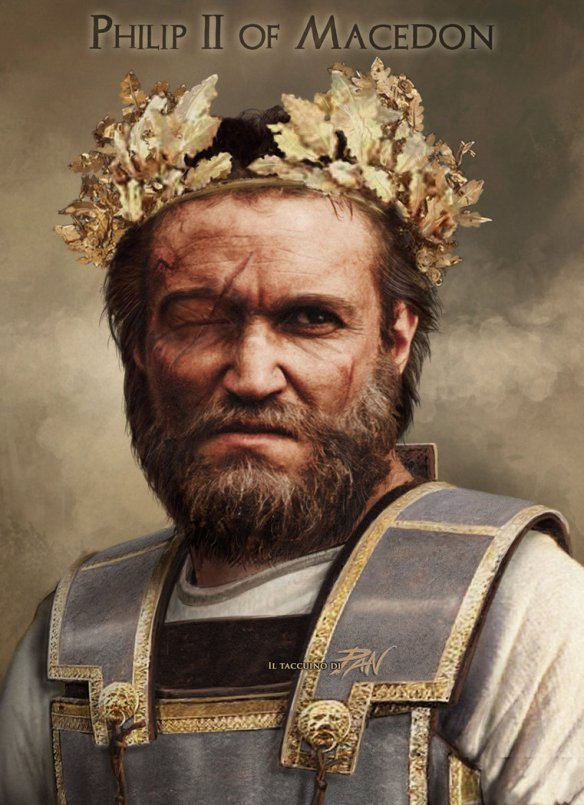
A Macedonian phalanx by Johnny Shumate.
At no time in Macedonian history did things look more dismal than in 360 BCE, when Balkan tribes killed the king and overran much of Macedon. But the king’s younger brother Philip immediately took control of the kingdom and initiated the reforms that would turn the Macedonian army into a well-organized war machine. The first step was raising the effectiveness of the peasant foot soldiers. Drawing on funds from silver mines, Philip introduced standardized weapons and the discipline of the phalanx formation. Within two years, he increased the size of the Macedonian army to over 10,000 and drove out the invaders. Not only did his victory strengthen the power of the monarchy, but the newly effective infantry balanced the political influence of the nobility.
Using his new strength, Philip introduced over the next twenty years further reforms in both organization and weaponry. He forged the Macedonian nobles into a drilled and disciplined heavy cavalry force organized by territorial squadrons. He gave them the title Companions (hetairoi) to emphasize their social and political relationship to the king, winning their loyalty to a more centralized military system and reducing their independent influence in the kingdom. They wore armor and carried a shorter version of the infantry sarissa, or pike, more suited to fighting on horseback. The Companions formed a mobile offensive strike force the equal in quality if not numbers to the best Persian cavalry and unmatched in any Greek army.
Philip also expanded the heavy infantry further, recruiting men from parts of Macedon that traditionally had been outside the direct control of the king, such as the rugged cantons of western Macedon, and tying them to the king with grants of land. Philip’s intention was to create an army of citizen-soldiers who derived their status from military service to the king, in effect fusing two sources of infantry cohesion: communal ties as developed in the Greek poleis, and centrally imposed drill and discipline. The result was the creation of a large Macedonian infantry force organized into territorial battalions. These units formed a phalanx of some 18,000 men, much larger than any Greek state could raise. Philip armed these troops with a sarissa roughly 15-18 feet long. The sarissa allowed Philip to lighten the armor of his infantry, providing them with a small shield strapped to the left arm and only light body armor. The sarissa and lighter armor increased both the mobility and the offensive striking power of the Macedonian phalanx, as multiple spear points now preceded the front line of soldiers into combat. To emphasize the royal nature of the infantry in the political structure of the realm, Philip called them his Foot Companions (pezhetairoi). Though their privileges did not match those of the noble Companion cavalry, the infantry received regular pay, which allowed them to maintain their farms by buying slaves or hiring labor, giving the Macedonian kings the best qualities of citizen militia and professional soldiers in one force.
The tactical combination of phalanx and heavy cavalry could be formidable, with the infantry acting as an anvil, holding the enemy for the hammer blow of the Companions. But these two heavy elements alone lacked flexibility and maintained connection with each other only with difficulty. The crucial third unit of the Macedonian army was, therefore, an infantry force of 3000 men who formed the Royal Guard-the hypaspists, or shield bearers. These men differed from the regular infantry in that they were not organized territorially, but were recruited from throughout the kingdom. Their equipment is a matter of much debate but seems to have included a larger shield than the men of the phalanx carried, a short sword, and a shorter, lighter spear. They were thus more lightly armed than the heavy infantry; their equipment, even more intensive drill, and their smaller units of organization made them more mobile than the phalanx. Thus, one role of the hypaspists was to act as a link or hinge between the phalanx and the heavy cavalry in set-piece battles. But their skill and tactical flexibility made the hypaspists useful for a variety of tasks, and under Philip’s son Alexander, they became the “special forces” unit of the army.
Philip also included light infantry and skirmishers in the regular army organization, and he added specialized troops from allies or mercenaries, including Thessalian heavy cavalry, Cretan archers, and Agrianian mountaineers. Such troops added both firepower and skirmishing and scouting capabilities to the army, giving Philip and later Alexander a set of tactical and operational tools that could meet almost any challenge. And, in fact, one important hallmark of Philip’s use of his new army was his ability to coordinate the various types of infantry and cavalry in a coherent battle plan.
Operationally and strategically, Philip emphasized mobility. He had his troops carry their own supplies and limited the number of pack animals. Unlike the forces of the Greeks, his army could campaign all year long. Philip also understood the importance of siege warfare and organized a mobile siege train that included engineers and war engines, some of which were light enough to be used as field artillery in battle. Philip had created a complete war machine.
Philip was now ready to take up the challenge of the pan-Hellenists and lead a great war against the barbarian Persians. Unfortunately, the Greeks considered him a barbarian, too. Therefore, he brought his army into Greece, and in 338 BCE at Chaeronea, he defeated an army of Athenians and Thebans, destroying the Sacred Band. During the battle, his son Alexander won distinction at the head of the Companion cavalry. By 336, Philip, now hegemon of the Greek League as well as king of Macedon and leader of Thessaly, was ready to invade Persia. He sent an advance guard to Asia Minor, but before he could join them, he was assassinated.